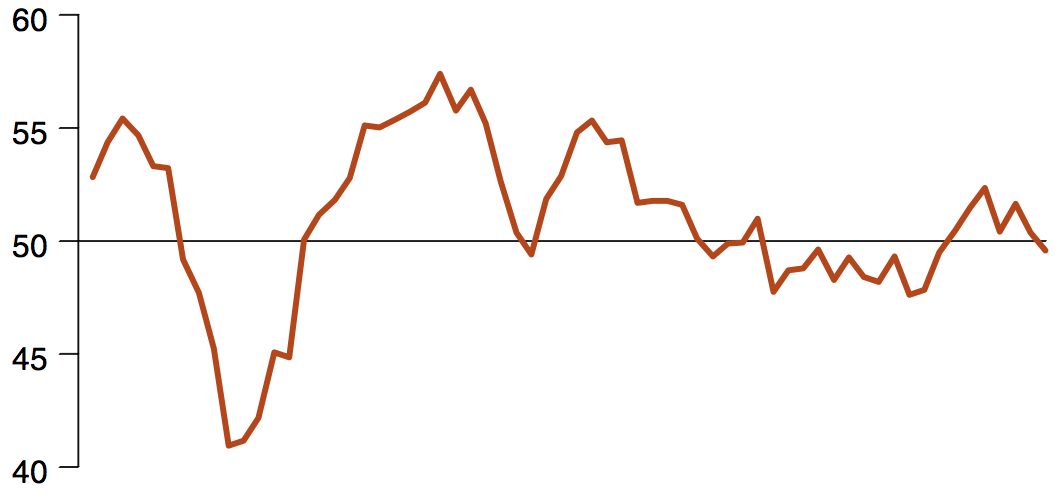Suddenly the going is getting tougher in our biggest export markets of China, South Korea, India and Taiwan – in fact it seems that apart from rebounding Japan, the rest of Asia is now seeing a slowdown in activity in its most important sector – manufacturing.
Europe is still weak – but seems to be slowly improving, but the US economy may be still under pressure, especially manufacturing.
And that will have important implications for Australia, especially if the slowing pace of activity in Asia continues is sustained over coming months. It is out biggest export destination and vital to national income.
A late rebound on Wall Street will soften the impact here today of yesterday’s weakness, but with the dollar rising more than a cent overnight, anything can happen to investment sentiment.
Already iron ore prices are falling as a result of the slow down, especially in China where steel production is starting to dip.
As a result of the news, the Japanese stock market fell 3.7% to a six week low – it is now down nearly 17% from its most recent peak. Our market fell to a four month low, dropping 38 points or 0.8% after being up in early trading.
The ASX200 index fell to 4888.3, the lowest since early February, while the All Ords dropped 40.3 points, or 0.8% to 4873.7.
The Aussie dollar edged back over 96 US cents to end locally around 96.40. In US trading the currency rose more than a cent to close around 97.55 US cents.
Gold was up $US3 an ounce in Asia and rose further in Europe and the uS to end up $US18 an ounce at $US1411. Oil ended higher after being weak in Asia on the weak manufacturing reports from the region.
That news of the worse than expected second reading of the state of Chinese manufacturing from HSBC kicked the market lower in the afternoon, as it did impact the rest of Asia.
The poor Chinese data showed a contraction in China’s small to medium manufacturers with the survey showing to 49.2 from the first reading last week of 49.6 and the final reading for April of 50.4. Saturday’s official survey showed a small rise to 5.08 in May from 50.6 in April.
China PMI slips back into contraction territory during May

Source: HSBC Purchasing Managers’ Index
Both can coexist because they reflect what is happening in different parts of the country’s gigantic manufacturing sector.
But other surveys across the region showed a contraction – Taiwan’s manufacturing sector contracted after expanding in April – the fall was from just over 50 to 47. The pace of expansion slowed in South Korea and India as exports and new orders dried up (a common point for most economies). Australia’s manufacturing survey showed a 7 point rise to 43.8 – still a slowing trend, but not at as dramatic a rate as seen in April.
That was the 23rd month in a row manufacturing has contracted (about how long the Aussie dollar has remained above or near parity with the greenback).
In Europe thought, there was good news in contrast to the slowdown across most of Asia.
Even though much of the eurozone remains in contraction, the pressures are easing.
The eurozone manufacturing purchasing managers’ index rose to 48.3 from April’s 46.7, coming in ahead of an earlier flash reading of 47.8.
But it was still the 22nd month it has been under the 50 level that divides growth from contraction (A bit like Australia then).
The reading though was the highest since February 2012 and is the first time the downturn has eased in four months.
The PMI for Germany, Europe’s largest economy, remained under the 50 level, but improved and it was a similar story in neighbouring France, the area’s second-biggest economy. Spanish and Italian PMIs also rose.
More survey details will be released mid week to take account of the services sector.
And even though the US survey showed a surprise fall to 49 from 51 in April, Wall Street ended higher, thanks to a big gain on the Dow and smaller rises for the S&P 500 and the Nasdaq.
Wall Street had been down on the news of the weak US reading, but nice comments about a Fed official about quantitative easing lifted confidence in late trading.
So for local shares, a rough end to the day with the likes of BHP down 2.3%, Rio Tinto off 2.5% because of the weak manufacturing data from China in particular.
Woolies was down 0.9% and Telstra off 1.7% (on fears about the rising cost of removing all the asbestos in its phone ducts). Newcrest rose 4.2% on the slightly higher gold price and Wesfarmers was up 0.3%. The banks were mostly stronger (after may’s sell off) with the ANZ up 1.1%, CBA, 0.1%, NAB, 1% and Westpac a solid 1.3%.
QBE, which was up nearly 20% in May, lost 2.2% yesterday.
Retail sales for April, out yesterday, showed a small rise of 0.2% (seasonally adjusted) after the 0.4% dip in March.
That was a bit lower than market hopes for a rise of 0.3. In the more accurate trend terms, retail sales rose 0.4% in April, after similar rises in March and February.
And, with the growth data out tomorrow, more figures on the March quarter showed there won’t be any boost to GDP from inventories which fell in the quarter, or from manufacturing or wholesale trade sales.
But wages and company profits were both higher in the quarter, which will be a positive.
House prices were down in May by around 1.2% after a half a per cent fall in April.
And job advertisements fell for the third consecutive month, and are now nearly 30% below their peak at the end of 2010, the monthly ANZ survey released yesterday showed.













